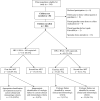Predicting virologic failure among HIV-1-infected children receiving antiretroviral therapy in Tanzania: a cross-sectional study
- PMID: 20216225
- PMCID: PMC4185279
- DOI: 10.1097/QAI.0b013e3181cf4882
Predicting virologic failure among HIV-1-infected children receiving antiretroviral therapy in Tanzania: a cross-sectional study
Abstract
Background: Many HIV care and treatment programs in resource-limited settings rely on clinical and immunologic monitoring of antiretroviral therapy (ART), but accuracy of this strategy to detect virologic failure (VF) among children has not been evaluated.
Methods: A cross-sectional sample of HIV-infected children aged 1-16 years on ART >or=6 months receiving care at a Tanzanian referral center underwent clinical staging, CD4 lymphocyte measurement, plasma HIV-1 RNA level, and complete blood count. Associations with VF (HIV-1 RNA >or=400 copies/mL) were determined utilizing bivariable and multivariate analyses; accuracy of current clinical and immunologic guidelines in identifying children with VF was assessed.
Findings: Of 206 children (median age 8.7 years, ART duration 2.4 years), 65 (31.6%) demonstrated VF at enrollment. Clinical and immunological criteria identified 2 (3.5%) of 57 children with VF on first-line therapy, exhibiting 3.5% sensitivity and 100% specificity. VF was associated with younger age, receipt of nevirapine vs. efavirenz-based regimen, CD4% < 25%, and physician documentation of maladherence (P < 0.05 on bivariable analysis); the latter 2 factors remained significant on multivariate logistic regression.
Interpretation: This study demonstrates poor performance of clinical and immunologic criteria in identifying children with virologic failure. Affordable techniques for measuring HIV-1 RNA level applicable in resource-limited settings are urgently needed.
Figures
Similar articles
-
Virologic Response to First-line Efavirenz- or Nevirapine-based Antiretroviral Therapy in HIV-infected African Children.Pediatr Infect Dis J. 2017 Jun;36(6):588-594. doi: 10.1097/INF.0000000000001505. Pediatr Infect Dis J. 2017. PMID: 28505015 Free PMC article.
-
Association between efavirenz-based compared with nevirapine-based antiretroviral regimens and virological failure in HIV-infected children.JAMA. 2013 May 1;309(17):1803-9. doi: 10.1001/jama.2013.3710. JAMA. 2013. PMID: 23632724 Free PMC article.
-
Detecting virological failure in HIV-infected Tanzanian children.S Afr Med J. 2014 Jun 26;104(10):696-9. doi: 10.7196/samj.7807. S Afr Med J. 2014. PMID: 25363057
-
Effectiveness of efavirenz-based regimens in young HIV-infected children treated for tuberculosis: a treatment option for resource-limited settings.PLoS One. 2013;8(1):e55111. doi: 10.1371/journal.pone.0055111. Epub 2013 Jan 25. PLoS One. 2013. PMID: 23372824 Free PMC article.
-
Role of non-nucleoside reverse transcriptase inhibitors in treating HIV-infected children.Drugs. 2011 Nov 12;71(16):2131-49. doi: 10.2165/11597680-000000000-00000. Drugs. 2011. PMID: 22035514 Review.
Cited by
-
Early virologic failure and the development of antiretroviral drug resistance mutations in HIV-infected Ugandan children.J Acquir Immune Defic Syndr. 2011 Jan 1;56(1):44-50. doi: 10.1097/QAI.0b013e3181fbcbf7. J Acquir Immune Defic Syndr. 2011. PMID: 21099693 Free PMC article.
-
Virologic Response to First-line Efavirenz- or Nevirapine-based Antiretroviral Therapy in HIV-infected African Children.Pediatr Infect Dis J. 2017 Jun;36(6):588-594. doi: 10.1097/INF.0000000000001505. Pediatr Infect Dis J. 2017. PMID: 28505015 Free PMC article.
-
Development of HIV drug resistance and therapeutic failure in children and adolescents in rural Tanzania: an emerging public health concern.AIDS. 2017 Jan 2;31(1):61-70. doi: 10.1097/QAD.0000000000001273. AIDS. 2017. PMID: 27677163 Free PMC article.
-
Incidence and predictors of treatment failure among children on first-line antiretroviral therapy in Amhara Region Referral Hospitals, northwest Ethiopia 2018: A retrospective study.PLoS One. 2019 May 1;14(5):e0215300. doi: 10.1371/journal.pone.0215300. eCollection 2019. PLoS One. 2019. PMID: 31042743 Free PMC article.
-
Viral load monitoring and antiretroviral treatment outcomes in a pediatric HIV cohort in Ghana.BMC Infect Dis. 2016 Feb 3;16:58. doi: 10.1186/s12879-016-1402-9. BMC Infect Dis. 2016. PMID: 26843068 Free PMC article.
References
-
- UNAIDS [July 6, 2009];Epidemiological fact sheet on HIV and AIDS: United Republic of Tanzania. http://www.unaids.org/en/KnowledgeCentre/HIVData/Epidemiology/epifactshe....
-
- Puthanakit T, Oberdorfer A, Akarathum N, et al. Efficacy of highly active antiretroviral therapy in HIV-infected children participating in Thailand's National Access to Antiretroviral Program. Clin Infect Dis. 2005 Jul 1;41(1):100–107. - PubMed
-
- Jaspan HB, Berrisford AE, Boulle AM. Two-year outcomes of children on nonnucleoside reverse transcriptase inhibitor and protease inhibitor regimens in a South African pediatric antiretroviral program. Pediatr Infect Dis J. 2008 Nov;27(11):993–998. - PubMed
-
- Resino S, J MB, Gurbindo D, et al. Viral load and CD4+ T lymphocyte response to highly active antiretroviral therapy in human immunodeficiency virus type 1-infected children: an observational study. Clin Infect Dis. 2003 Nov 1;37(9):1216–1225. - PubMed
-
- Fassinou P, Elenga N, Rouet F, et al. Highly active antiretroviral therapies among HIV-1-infected children in Abidjan, Cote d'Ivoire. AIDS. 2004 Sep 24;18(14):1905–1913. - PubMed
Publication types
MeSH terms
Substances
Grants and funding
LinkOut - more resources
Full Text Sources
Medical
Research Materials


